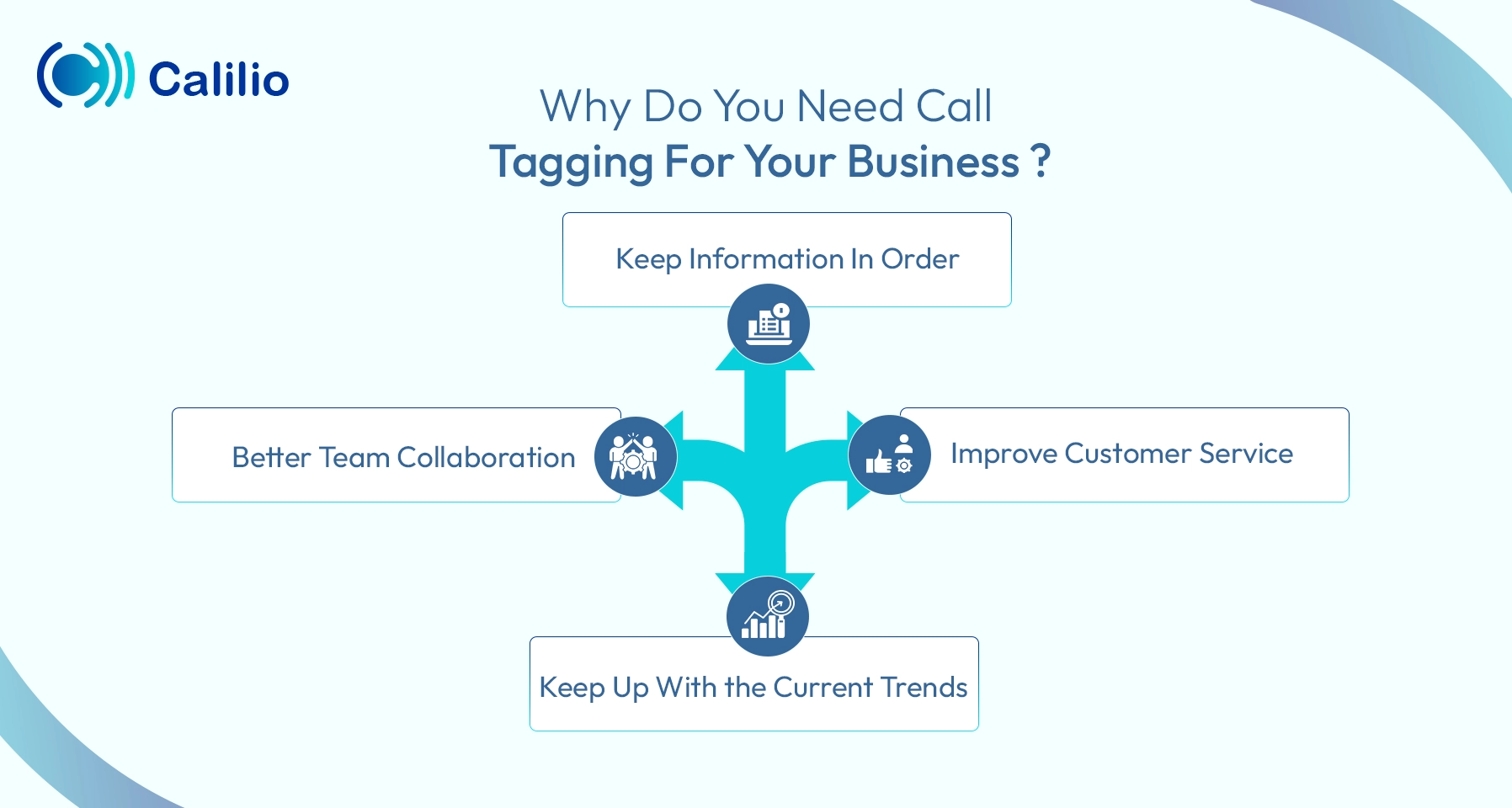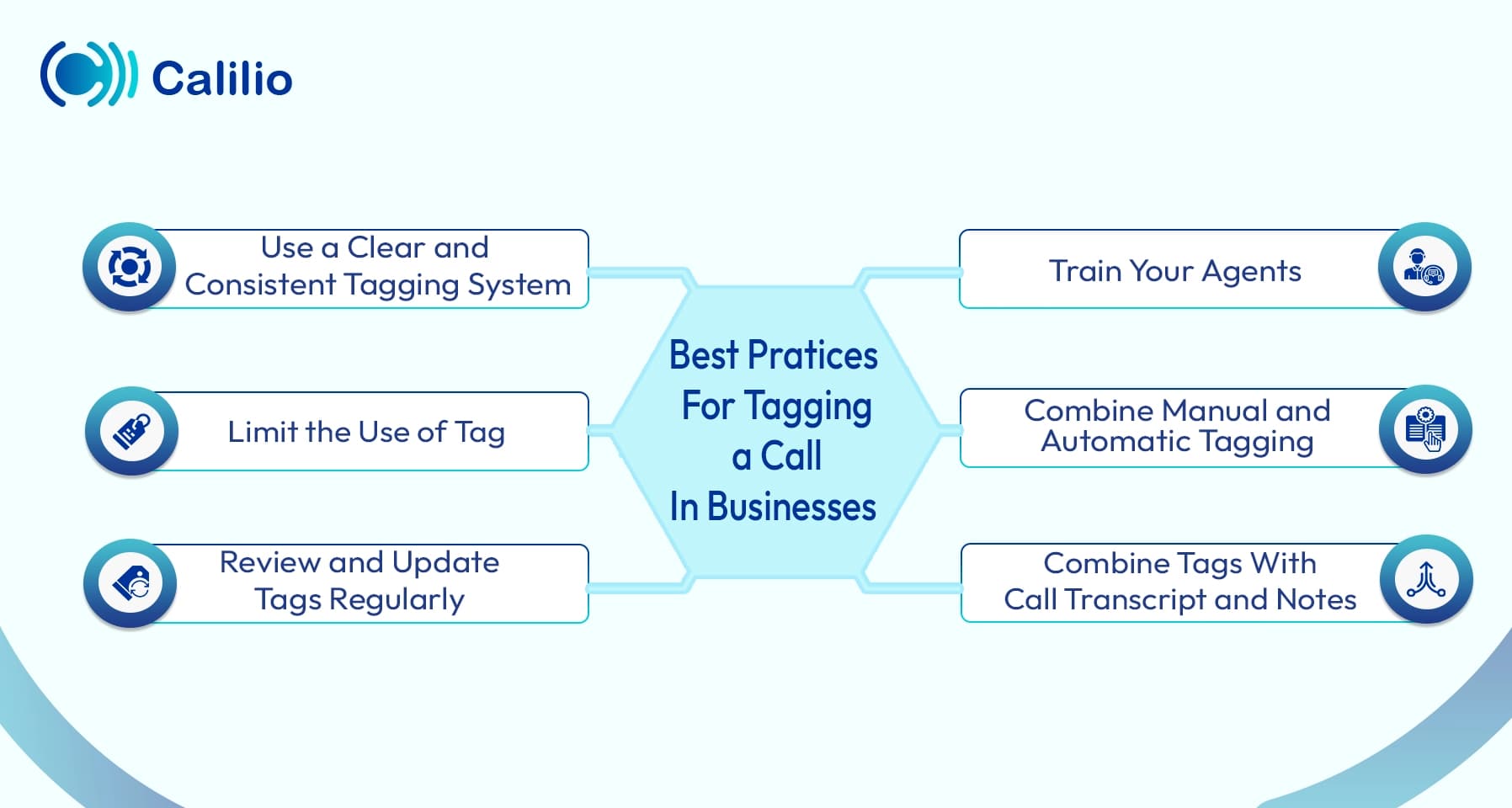What is Call Tagging? How to Label and Track Business Calls?

Summarize this blog with:
Your team speaks with customers every day - answering questions, solving problems, closing deals. But after the call ends, how do you keep track of what happened? Without a clear system, important details can get lost, follow-ups can be delayed, and your workflow can slow down. This can negatively impact customer experience and your team's efficiency.
That’s why many businesses today are turning to call tagging, a simple way to label calls based on the topic, urgency, or outcome. With the right tags in place, your team can quickly organize and review calls and take the right actions for follow-ups.
In this blog, you’ll learn what a call tag is, how it works, why it matters, its limitations, and best practices.
Key Highlights:
Call tagging is the process of labeling business calls with short, clear tags based on the topic, urgency, or outcome.
Tags can reflect different call types such as product inquiries, service feedback, billing issues, or support requests.
Call tags help businesses organize call data, track follow-ups, and improve team coordination and customer service.
Poor tagging practices, like inconsistent tag usage or unclear tag lists, can reduce accuracy and create confusion.
To tag calls effectively, use consistent tags, train agents, leverage both manual and automatic tagging, and review tag lists regularly.
What Is Call Tagging?
Call tagging is a business phone system feature that allows you to label a phone call with specific tags or keywords based on the call topic, outcome, or urgency. These tags serve as quick references, making it easy to understand the nature, purpose, or conclusion of the call without having to listen to recordings or read through detailed notes.
Instead of writing long notes, your agents can tag a call with terms like “new lead,” “product issue,” “billing question,” or “follow-up needed.” These tags are attached to the call record, so you can easily search or sort past conversations.
For example, your agent takes a call from a customer asking for a refund. Instead of writing a full paragraph, they can simply tag the call with labels like “refund request,” “urgent,” or “angry customer.”
How Does Call Tagging Work?
Call tagging works by assigning specific tags or keywords to phone calls, either during or after the call. These tags categorize calls based on their purpose, content, or outcome, making it easier to organize, search, and analyze call data later.
Here’s a breakdown of how it works in a business phone system.
- Call Takes Place: A customer calls your business, or your team makes an outbound call.
- Agent Handles the Conversation: During the call, the agent listens, responds, and resolves the customer's issue or collects key information.
- Tag Is Applied: Once the call ends (or sometimes during the call), the agent adds one or more tags based on what was discussed.
- Tags Are Stored With Call Data: The tags are saved in the system along with the call log.
- Use Tags for Review: Supervisors or team members can filter calls by tag to monitor trends, track unresolved issues, or prepare for follow-ups.
Get a Cloud Phone System and Label Calls, Leave Notes & Follow Up Faster!
What are the Different Types of Call Tagging?
There are two types of call tagging: manual and automatic. Businesses can choose based on how they manage call data and how much automation they want.
- Manual Call Tagging: In this method, the agent assigns tags. After actively listening to the calls, they manually allocate a set of keywords based on the interaction.
- Automatic Call Tagging: This method utilizes AI to analyze conversations and apply tags based on topics and patterns. It works without requiring manual input from agents.
Why Do You Need Call Tagging For Your Business?
Tags make it easier to sort and search through call records, monitor team performance, and analyze trends in customer interactions. They’re beneficial for improving customer service, training new agents, and streamlining call management.
Keep Information In Order
With call tags, you can label each call clearly based on its topic or outcome. This keeps your call records organized and easy to search. Your staff can quickly find past conversations without going through long notes or full recordings.
Improve Customer Service
Tags show what the issue was, what was done, and what still needs attention. When agents understand the customer’s past calls, they can respond faster and more accurately. This leads to quicker resolutions, reduces average wait time, and improves customer experience.
Better Team Collaboration
Tags give all team members a clear view of each call. Anyone reviewing the call later will understand what it was about and what action is needed. This improves handovers and reduces confusion.
Keep Up With the Current Trend
Tags help you spot patterns in customer behavior, common issues, or frequent requests. Based on the insights, your business can improve products, train your staff, or adjust strategies.
What are the Limitations of Call Tags?
Call tags often come with limitations such as inconsistent usage, limited context, and manual errors. Similarly, without automation, it also adds extra workload to the agents.
- Inconsistent Tag Usage: Agents may use different tags for the same type of call, making reports unclear and more complex to track and analyze.
- Limited Context: Tags indicate the subject of the call, but lack specific details. Without notes, it may be difficult to fully understand the conversation.
- Dependence on Predefined Tags: If the system only allows fixed tags, sometimes, you may not find one that fits the context of the call. This can lead to skipped or incorrect tags.
- Potential for Misclassification: Agents may choose the incorrect tag due to error or a lack of clarity, which can impact reporting and follow-ups.
- Limited Automation: If your system doesn’t support automatic tagging, all tagging must be done manually. This adds more work for agents and also increases the chance of errors.
Best Practices For Tagging a Call In Businesses
To maximize the value of call tagging, use a clear and consistent tag list, train agents on proper tagging practices, and limit the number of tags to prevent confusion. Additionally, combine manual and automated tagging and regularly review tags to improve accuracy and efficiency.

1. Use a Clear and Consistent Tagging System
Begin with a well-organized list of tags that accurately reflect common call types, such as product issues, reviews, technical support, billing, price inquiries, and feedback. Keep tags short, specific, and easy to understand to avoid confusion.
2. Train Your Agents
Ensure that everyone is aware of when and how to apply tags. Include tagging in your onboarding and ongoing training programs so your team uses the system consistently. It helps to reduce tagging errors and improve data quality.
3. Limit the Use of Tag
Using too many tag options can confuse agents and slow down their workflow. Keep the calling tag list short and relevant to your business needs.
4. Combine Manual and Automatic Tagging
Use both manual and automatic phone tagging to save time and improve accuracy. Let your AI-based system handle basic or repeated tags automatically. Allow agents to tag calls manually that require additional human understanding or context.
5. Review and Update Tags Regularly
As your business grows, it's essential to keep your calling tags up to date. Regularly review your tag list to remove outdated tags and add new ones that accurately reflect your current processes, goals, and objectives.
6. Combine Tags With Call Transcripts and Notes
Use call tags with other call data, like notes or call transcripts, for full context. Combining these features gives a more complete picture of customer needs and behavior.
Conclusion
Call tagging is a simple but powerful way to manage and organize business calls. It helps your team label conversations clearly, track important details, and respond more effectively. When combined with notes and advanced call handling tools, it improves team coordination and customer service.
Calilio Introduces Affiliate Program
Earn 30% lifetime commission on every paid referral.
Turn your audience, network, or customers into a recurring revenue stream.

30% recurring commission on every paid referral

Lifetime earnings for as long as the customer stays subscribed

Unique referral link with real-time tracking

Perfect for agencies, consultants, creators, and SaaS partners

Frequently Asked Questions
Can I create or customize tags for my team?
Yes, most business phone systems allow you to add or edit tag lists in settings. You can customize tags to reflect your business processes, campaigns, or customer segments.
What’s the difference between call tagging and call notes?
Can multiple tags be applied to a single call?
How many call tags should a business use?

Still have questions?
Can’t find the answer you’re looking for? Please chat with our friendly team.
Stay in the loop
Get the latest call insights, trends, and updates delivered straight to your inbox.
By subscribing, you agree to receive updates from Calilio.
You can unsubscribe anytime.